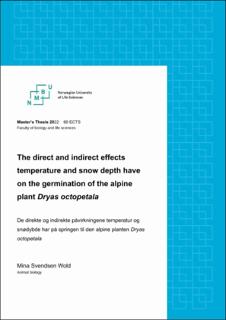| dc.contributor.advisor | Roos, Ruben | |
| dc.contributor.author | Wold, Mina Svendsen | |
| dc.date.accessioned | 2022-11-09T13:12:59Z | |
| dc.date.available | 2022-11-09T13:12:59Z | |
| dc.date.issued | 2022 | |
| dc.identifier.uri | https://hdl.handle.net/11250/3030957 | |
| dc.description.abstract | High-arctic ecosystems are facing rapid changes due to climate change. These regions are predicted to be heavily affect and see changes at a higher rate than any other. Temperature and snow depth are two climatic factors that heavily influences the arctic landscape. They affect the flora`s growing season, reproductive success, and seed germination. They can also have an indirect effect on flora by affecting the seed mass, length, and microbial activity. A plant’s ability to have successful sexual reproduction determines the species genotype and its ability to withstand climatic changes in the future. The purpose of this study was to have in suito snow fence experiments at Adventdalen and temperature manipulation experiments (OTC) at Endalen, that explored how snow depth and temperature affects the germination rate of Dryas octopetala L (hereafter D.octopetala). D.octopetala is a widely distributed arctic dwarf shrub, that has a long lifespan, relatively early spring activity, and similar reproductive rates as other arctic dwarf shrubs. The seeds for the temperature treatment were collected by Simone Lang in 2020 and the seeds for the snow-depth treatment were collected by Elizabeth Cooper, in 2020. The germination itself was conducted under optimal conditions in a climate room on agar. Information about the seeds mass, seed length, day germination started, day germination ended, and mold occurrence were registered. The data was analyzed with general linear regression models and ggplots. For the snow depth treatment, the variables “treatment method”, “seed mass” and “mold” occurrence seemed to influence the seed’s ability to germinate. Seed length had no effect on germination. Snow depth also appears to have an indirect effect on seed mass and mold. For the OTC treatment, treatment, mass, and mold appears to influence seed germination, however treatment to a lesser degree. OTC treatment also appears to have an indirect effect on seed mass and mold occurrence. The results from this experiment indicates that snow depth and temperature have possibly direct and indirect effect on D.octopetala`s germination | en_US |
| dc.description.abstract | Høyarktiske økosystem står ovenfor hyppig forandring grunnet klimaendringer. Det er forutsett at disse områdene kommer til å bli påvirket i stor grad og kommer til å se forandringene raskere enn noen andre. Temperatur og snødybde er to klimatiske faktorer som i stor grad påvirker det arktiske landskapet. De påvirker lengden på vekst sesongen, reproduktiv suksess og frøspringen til floraen. De kan også ha en indirekte effekt på floraen, ved å påvirke frø masse, lengde og mikrobiell aktivitet. En plantes evne til å ha vellykket seksuell reproduksjon bestemmer artens genotype og dens evne til å motstå klimatiske endringer i framtiden. Formålet med dette studiet var å ha «in-suito» snø gjerdet eksperimenter på Adventdalen (snødybde) og varmebehandlinger (OTC) på Endalen (temperatur), som utforsket hvordan snø dybde og temperatur påvirket springen til Dryas octopetala L (heretter kjent som D.octopetala). D.octopetala er en bredt utbredt arktisk dvergbusk, som har lang levetid, tidlig våraktivitet og har lignende reproduksjonsrater som andre arktiske dverg busker. Frøene fra temperatur behandlingen ble innsamlet av Simone Lang i 2020, og frøene for snø dybde behandlingen ble samlet inn av Elizabeth Cooper i 2020. Selve spiringen ble gjennomført under gunstige forhold i et klima-rom på agar. Informasjon om frøenes masse, lengde, dagen spiringen startet, dagen spiring var ferdig og mugg ble registrert. Dataene ble analysert med generell lineær regresjons modeller og ggplot. For snø dybde behandlingene påvirket variablene «behandling», «frø masse» og «mugg», frøets evne til å spire. «Frø lengde» hadde ingen påvirkning på spiringen. Det virket som om snø dybde hadde en indirekte effekt på «frø masse» og «mugg». For OTC behandling hadde variablene «behandling, «masse» og «mugg» en mulig effekt på frø spiringen, men behandling i en minndre grad. Det virker også som om OTC behandlingen har en indirekte effekt på «frø masse» og «mugg» forekomst. Resultatene i dette forsøket indikerer at snø dybde og temperatur har en mulig direkte og indirekte effekt på D.octopetala`s spiringsrate. | en_US |
| dc.language.iso | eng | en_US |
| dc.publisher | Norwegian University of Life Sciences, Ås | en_US |
| dc.rights | Attribution-NonCommercial-NoDerivatives 4.0 Internasjonal | * |
| dc.rights.uri | http://creativecommons.org/licenses/by-nc-nd/4.0/deed.no | * |
| dc.title | The direct and indirect effects temperature and snow depth have on the germination of the alpine plant Dryas octopetala | en_US |
| dc.title.alternative | De direkte og indirekte påvirkningene temperatur og snødybde har på springen til den alpine planten Dryas octopetala | en_US |
| dc.type | Master thesis | en_US |
| dc.subject.nsi | VDP::Landbruks- og Fiskerifag: 900 | en_US |
| dc.source.pagenumber | 43 | en_US |
| dc.description.localcode | M-BIOL | en_US |

